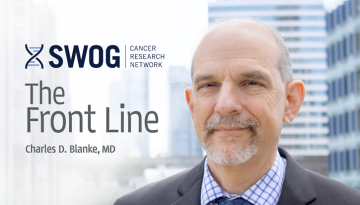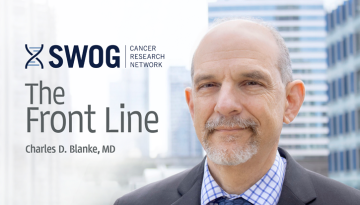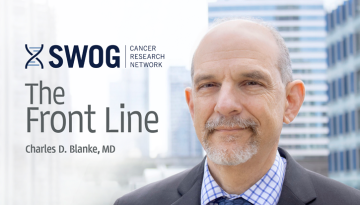SWOG's Pandemic Accrual: Facts and More Facts
Just how bad – or good – our trial enrollment has been during the pandemic depends on your perspective. Are you a glass half full – or half empty – kind of person? Everyone looks at the same situation with a different lens, so I’ll give you just the facts on our accrual this spring. You can decide whether SWOG Cancer Research Network was dealt a blow, or dodged a bullet.
One thing is for sure. It could have been much worse.
Thanks to Cathy Rankin and others at the SWOG Statistics and Data Management Center, we’ve got numbers. First, the stats crew crunched accrual for the six weeks prior to the pandemic, from Feb. 3 to March 13, and came up with an average. Then they looked at accrual between March 13 and and April 30, and also came up with an average. Then they compared.
Overall, SWOG’s NCTN trials saw a 30 percent average weekly decrease, compared to the six-week, pre-pandemic average. Our NCORP trials saw a 55 percent decrease. This discrepancy isn’t surprising. Across the country, many health centers were focused on critical care, rather than population science, in late March and April. Meanwhile, some large hospitals and cancer centers issued pandemic policies stating that physicians could only enroll patients on trials that had immediate benefit to patients. This means treatment trials were options – but not prevention, survivorship, or cancer care delivery studies. SWOG actually did very well here in relation to the rest of the NCTN.
Put the NCORP and NCTN numbers together and SWOG saw a 38 percent drop in average weekly enrollment from mid-March through the end of April when compared to dates in February through mid-March. As an optimist – only when it comes to SWOG! – I think our accrual numbers are not disastrous. In fact, some SWOG trials actually did better! Compared with six weeks of pre-pandemic data, these trials saw an enrollment increase in the six weeks after the pandemic hit: S1806 and S1602 from the GU committee, S1512 and S1607 from the melanoma committee, as well as two sub-studies featured in Lung-MAP, our master lung protocol. Not too bad.
Of course, much depends on where our members live, and how coronavirus has affected the area around them.
States like New York, New Jersey, Michigan, Illinois, and Massachusetts have been hit hard, as have cities like New York, New Orleans, and Detroit. Rural areas in Tennessee, Nebraska, Arkansas, and Minnesota are hot spots, as well. At the same time, big swaths of the country, comparatively, haven’t been hit hard at all. That’s why some hospitals could keep accruing normally, others couldn’t accrue at all, and most experienced a slight drop because their focus was on pandemic planning and clinical care.
Whether you enrolled patients to SWOG trials or not, I want to thank staff at every single SWOG site for your efforts these past three months. We’re all operating in a crisis, and doing the best we can for each other and for patients. But I would be remiss if I didn’t give a shout-out to Gulf South, Catholic Health, University of Kansas, and Southeast NCORPS for double-digit accrual for the combined months of March and April, and to staff at our main member sites at the University of Oklahoma Health Sciences Center, Fred Hutchinson Cancer Research Center, and Oregon Health & Science University for their double-digit accrual as well.
Please stay healthy. And take heart in knowing that our trials all remain open and are accruing patients. As well, new concepts continue to be developed and approved. We’ve been here since 1956, and we’re still going strong. For our patients!
Other Recent Stories



